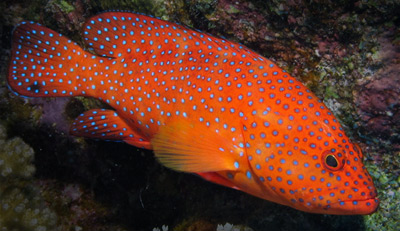The name “grouper” conjures up images of underwater behemoths that no home aquarium can conceivably accommodate, such as the legendary goliath grouper (Epinephelus itajara). Fortunately, marine aquarium hobbyists who have a yen for these hefty predators can find several attractive, aquarium-sized species in the genus Cephalopholis, including the justifiably popular miniata grouper (C. miniata), aka the coral hind.
Physical traits
C. miniata has a robust, bass-like body shape. It’s a mottled orange-red to scarlet in base color with myriad small, closely spaced, light-blue polka dots all over its body and fins. Specimens purchased as juveniles will be more yellow-orange overall. The maximum reported length for this species is over 19 inches, but most captive specimens are unlikely to exceed a foot in total length.
Feeding
According to Fishbase, the miniata grouper’s natural diet consists predominantly of fish, the bulk of which are lyretail anthias (Pseudanthias squamipinnis), but crustaceans are on its menu as well. Captive specimens will accept a wide variety of fresh and frozen meaty foods of marine origin. Feed twice weekly to every other day.
Housing
Though C. miniata is small by grouper standards, it is, nonetheless, a sizeable fish and heavy polluter that can put a serious burden on water quality. Thus, you don’t want to skimp on tank size for this species. I wouldn’t go any smaller than 100 gallons (bigger is better, especially if you want to keep other fish too), and be sure the setup provides robust filtration and vigorous protein skimming. Also, the tank should be aquascaped to create several suitably sized caves and ledges that the coral hind can refuge in/under.
Compatibility
It probably goes without saying, but any fish small enough to be swallowed should not be housed with a coral hind. The same applies to crustaceans. Conspecifics will likely fight, so it’s best to keep this species one to a tank. Otherwise, similar-sized or larger fish species that are bold enough to stand up to the hind (without bullying it, of course)—such as certain community-friendly triggers, surgeonfishes, rabbitfishes, larger angelfishes, and larger wrasses—should make suitable companions.
C. miniata is technically reef-safe in that it won’t eat or nip at corals, but I would generally discourage its inclusion in reef systems nonetheless. Its messy eating/heavy excreting habits will tend to strain water quality beyond what’s acceptable in a reef system. Also, this species, in common with other hinds, has a tendency to come to rest on substrates, which can irritate, topple, or break corals.




